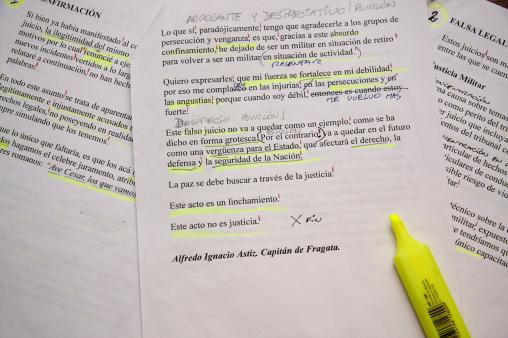Open! publica Un ensayo de interpretaciones inadecuadas
The lawyer often compared the justice system to theatre. He understood that there was a performative logic to the nature of law, which was the result of the fundamental indeterminacy of legal discourses. It allowed him to transform a political trial from a mere instrument of power into a cultural artefact that was capable of provoking a public reflection on hegemonic norms and transforming the law itself. “A trial is a place of metamorphosis,” he was known to say, “Joan of Arc wouldn’t have been a saint without her trial.”
Open! has just published our text on the historical and didactic nature of the political trial. Read an excerpt below.
The political trial as a cultural artifact
“Proceed”, said the newly elected president of Argentina, Néstor Kirchner. It was the 24th of March 2004, and an audience of ministers, high-ranking military officers and journalists watched a man in uniform step forward onto a small ladder, propped against the wall of the gallery in the Military Academy. Cameras flashed, as he took down the stately portraits of General Videla and General Bignone, almost 20 years after the fall of their violent regime. It was a powerful, symbolic gesture that indicated a clean break with those institutions and policies that had failed to address the lingering legacy of the military junta.
Just a couple of years earlier, at the peak of the economic crisis in Argentina, the streets were filled with people shouting “Que se vayan todos!” (“They all must go!”). People were banging pots and pans and burning down the banks, and they managed to topple four presidents in less than three weeks. Popular power was reconstituting itself outside of traditional party politics in the form of neighbourhood assemblies, arts collectives, bartering clubs and occupied factories.
Kirchner had been elected with a bare twenty-two percent of the votes and faced the task of recuperating the state’s lost credibility. By taking down these photos, he demonstrated that he was willing to dismantle the establishment and take on the powerful actors who controlled it from behind the scenes. Before his first term as president was over he had purged the armed forces and the police, impeached judges from the Supreme Court on charges of corruption and repealed the two infamous amnesty laws that had protected the perpetrators of human rights abuses during the dictatorship.
A historical process had been set in motion. But to fully understand the instrumentality of this moment would be like removing the front of a clock to reveal an obscure mechanism of contradictory movements behind the straightforward logic of the turning hands. Everything is connected but each turn of the interlocking cogs only appears to result in the rotation of another one in the opposite direction.








